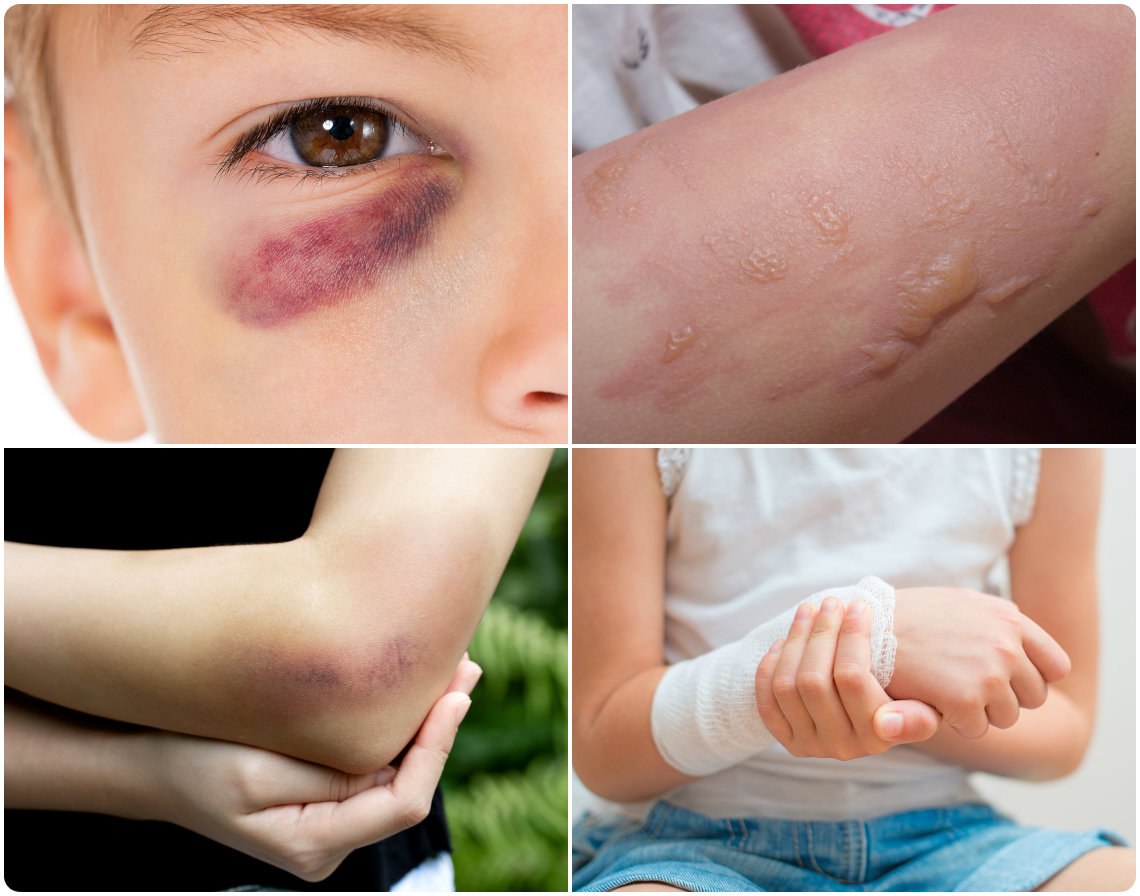Types & Signs
To identify signs of possible abuse and neglect in children and young people under the age of 18, the National Institute For Health and Care Excellence (NICE) has issued a series of maltreatment guidelines to healthcare professionals.
Below are some examples and sites of non-accidental injury, which typically cause suspicion to be raised.

Bruises
- Shape, pattern and age of bruises.
- Bruises shaped like hands, ligatures or identifiable implements.
- Bruises on non-bony parts of the body, face and ears.
- Multiple bruises or clustered bruises.
- Bruising in a non-mobile child.
- Bruising over soft tissues.
Bites
- Any bite which appears human.
- Small bite marks require adequate explanation.
- Animal bites are sign of poor supervision.
Lacerations & Abrasions
- Symmetrical in shape or location.
- On ankles or wrists – signs of a ligature.
- In non-mobile children.
- Around the face.
Thermal Injuries, burns & scalds
- Implement shaped – like a cigarette or iron.
- Scalds with borders - immersion injury.
- Buttocks & back.
- Soles of feet.
- Backs of hands.
Fractures
- Single or multiple in children without predisposed medical condition.
- Rib fractures – indicate grabbing, squeezing, shaking.
- Different age of fractures.
- Spiral fractures.
Intracranial Injuries
- Infant head injury – often known as Shaken Baby Syndrome.
- Any without adequate explanation.
- In a child under age of 3.
- Along with any multiple subdural haemorrhages.
- In the presence of retinal haemorrhage.
- Alongside rib or long bone fractures.
Eye Trauma
- Retinal haemorrhage with no medical explanation.
- Bleeding - retinal, pre-retinal, intra retinal, sub-conjunctival etc
Spinal injuries or visceral injuries
- Present without a history of major trauma.
Fabricated illnesses
- Any potentially induced illnesses.
- Poisoning.
Infant Death
- Sudden Infant Death Syndrome.
- Unexplained or implausible accidents.
- Signs of smothering.
Key non-accidental injury safeguarding questions
When trying to detect and identify cases of non-accidental injury, a wide range of factors are taken into account and points considered.
- Presentation of the child: Are there multiple injuries?
- Medical history: Is it variable or inconsistent with the injuries seen?
- Timeframes involved: Is there a delay in seeking medical attention?
- A&E Attendance: Are there multiple occurrences? Or frequent access?
- Developmental stage: Are the findings consistent with the child’s age?
- Signs of neglect: Is the child unkempt, smelly or dirty?
Have you been told to seek legal advice by the Police or Social Services?
Are they refusing to accept your explanation for an injury?
Call 0800 123 456 and tell us what’s happened – our solicitors are available 24 hours a day!
Pepperells Limited, registered in England and Wales: No. 10244781 | Registered Office: 100 Alfred Gelder Street, Hull, East Yorkshire, HU1 2AE | Authorised & Regulated by The Solicitors Regulation Authority | Regulation Authority Number 636188, 638554, 638556, 647027, 636188, 807163 and 818433. | www.sra.org.uk
Pepperells Solicitors are committed to ensuring that all Partners, Consultants and Employees give their full co-operation to the Legal Ombudsman in the event of any dispute or complaint against our firm, contact details of which can be found at www.legalombudsman.org.uk. VAT No. 365 0589 36
